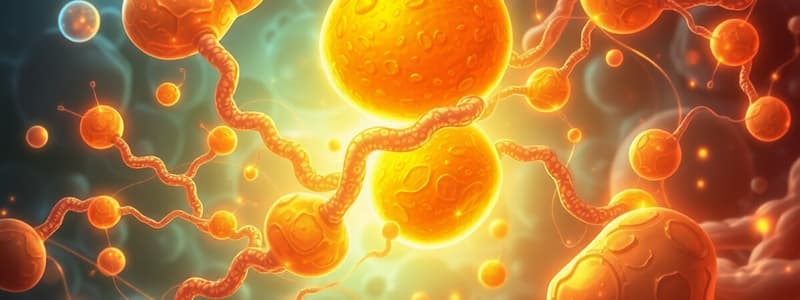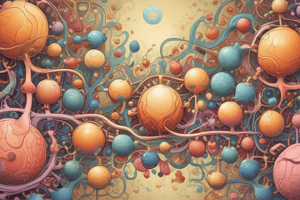Podcast
Questions and Answers
Which statement about fat storage is correct?
Which statement about fat storage is correct?
- Fats carry more energy per carbon than polysaccharides. (correct)
- Fatty acids complex more water compared to glucose.
- Fats provide short-term energy storage.
- Fats are less efficient than carbohydrates in energy storage.
What is the primary role of chylomicrons in lipid metabolism?
What is the primary role of chylomicrons in lipid metabolism?
- To break down triglycerides into fatty acids.
- To transport dietary fatty acids into the blood. (correct)
- To deliver energy for immediate use in muscles.
- To store glucose as glycogen.
What happens to fatty acids released from chylomicrons during transport?
What happens to fatty acids released from chylomicrons during transport?
- They undergo oxidation in the liver first.
- They are directly used for energy without regulation.
- They are converted to glucose for energy.
- They bind to serum albumin for distribution in blood. (correct)
Which process describes the conversion of diacylglycerol (DAG) to monoacylglycerol (MAG)?
Which process describes the conversion of diacylglycerol (DAG) to monoacylglycerol (MAG)?
What is the advantage of using fats as an energy source in mammals?
What is the advantage of using fats as an energy source in mammals?
What do medium chain triglycerides (MCT) primarily help with in lipid metabolism?
What do medium chain triglycerides (MCT) primarily help with in lipid metabolism?
Which is NOT a significant pathway for fatty acid mobilization?
Which is NOT a significant pathway for fatty acid mobilization?
How do fatty acids enter the myocyte for oxidation?
How do fatty acids enter the myocyte for oxidation?
What is the effect of PKA on glycogen synthase?
What is the effect of PKA on glycogen synthase?
What happens to glycolysis when PKA is activated?
What happens to glycolysis when PKA is activated?
In the process of converting fatty acids for mitochondrial oxidation, what is formed from fatty acid, CoASH, and ATP?
In the process of converting fatty acids for mitochondrial oxidation, what is formed from fatty acid, CoASH, and ATP?
What is required for the transport of large fatty acids into mitochondria?
What is required for the transport of large fatty acids into mitochondria?
How does glycerol enter glycolysis?
How does glycerol enter glycolysis?
What is the primary function of PFK-2 in relation to glucose metabolism?
What is the primary function of PFK-2 in relation to glucose metabolism?
Which statement correctly describes the fate of small fatty acids in relation to their mitochondrial entry?
Which statement correctly describes the fate of small fatty acids in relation to their mitochondrial entry?
What is the main product of the first stage of fatty acid oxidation?
What is the main product of the first stage of fatty acid oxidation?
During the hydration step of β-oxidation, what compound is formed on the β carbon?
During the hydration step of β-oxidation, what compound is formed on the β carbon?
What is the role of NAD in the β-oxidation pathway?
What is the role of NAD in the β-oxidation pathway?
After the oxidation of unsaturated fatty acids, what happens to FADH2 production?
After the oxidation of unsaturated fatty acids, what happens to FADH2 production?
Which isoform of acyl-CoA dehydrogenase works with fatty acids containing 12-18 carbons?
Which isoform of acyl-CoA dehydrogenase works with fatty acids containing 12-18 carbons?
What is the final step in β-oxidation that releases acetyl-CoA?
What is the final step in β-oxidation that releases acetyl-CoA?
What is the net reaction of the β-oxidation pathway?
What is the net reaction of the β-oxidation pathway?
How many ATP are produced from one molecule of NADH during the oxidation process?
How many ATP are produced from one molecule of NADH during the oxidation process?
What is the total ATP yield from the oxidation of one molecule of Palmitoyl-CoA?
What is the total ATP yield from the oxidation of one molecule of Palmitoyl-CoA?
Which enzyme is responsible for the formation of FADH2 during β oxidation?
Which enzyme is responsible for the formation of FADH2 during β oxidation?
Which of the following enzymes produces NADH in the citric acid cycle?
Which of the following enzymes produces NADH in the citric acid cycle?
How many FADH2 molecules are produced from the oxidation of Palmitoyl-CoA?
How many FADH2 molecules are produced from the oxidation of Palmitoyl-CoA?
What is the role of adenylyl cyclase in the activation of PKA?
What is the role of adenylyl cyclase in the activation of PKA?
Which enzyme directly converts diacylglycerol (DAG) to monoacylglycerol (MAG)?
Which enzyme directly converts diacylglycerol (DAG) to monoacylglycerol (MAG)?
Which enzyme is analogous to succinate dehydrogenase in the TCA cycle during fatty acid oxidation?
Which enzyme is analogous to succinate dehydrogenase in the TCA cycle during fatty acid oxidation?
What is the end product of the reaction performed by acyl-CoA acetyltransferase (thiolase)?
What is the end product of the reaction performed by acyl-CoA acetyltransferase (thiolase)?
Flashcards
Lipid Metabolism
Lipid Metabolism
The process of digesting, mobilizing, and oxidizing fats for energy production and storage, including fatty acid synthesis and cholesterol metabolism.
Fatty Acid Oxidation
Fatty Acid Oxidation
A major energy source, providing about 80% of energy to the heart and liver.
Fat Storage Efficiency
Fat Storage Efficiency
Fatty acids store more energy per carbon compared to carbohydrates and require less water for storage.
Chylomicrons
Chylomicrons
Signup and view all the flashcards
Fat Mobilization
Fat Mobilization
Signup and view all the flashcards
Adipose Tissue Release
Adipose Tissue Release
Signup and view all the flashcards
Lipid Transport in Blood
Lipid Transport in Blood
Signup and view all the flashcards
Fatty Acid Use by Myocytes
Fatty Acid Use by Myocytes
Signup and view all the flashcards
PKA's role in glucose homeostasis
PKA's role in glucose homeostasis
Signup and view all the flashcards
Glycogen metabolism regulation by PKA
Glycogen metabolism regulation by PKA
Signup and view all the flashcards
Glycolysis inhibition by PKA
Glycolysis inhibition by PKA
Signup and view all the flashcards
Glycerol entry into glycolysis
Glycerol entry into glycolysis
Signup and view all the flashcards
Fatty acid transport into mitochondria
Fatty acid transport into mitochondria
Signup and view all the flashcards
Fatty acyl-CoA formation
Fatty acyl-CoA formation
Signup and view all the flashcards
Fatty acid transport into mitochondria (further detail)
Fatty acid transport into mitochondria (further detail)
Signup and view all the flashcards
Acyl-Carnitine/Carnitine Transporter
Acyl-Carnitine/Carnitine Transporter
Signup and view all the flashcards
NADH and FADH2 Role
NADH and FADH2 Role
Signup and view all the flashcards
ATP Yield from Palmitoyl-CoA
ATP Yield from Palmitoyl-CoA
Signup and view all the flashcards
Acyl-CoA dehydrogenase
Acyl-CoA dehydrogenase
Signup and view all the flashcards
Beta-Hydroxyacyl-CoA dehydrogenase
Beta-Hydroxyacyl-CoA dehydrogenase
Signup and view all the flashcards
Citric Acid Cycle ATP production
Citric Acid Cycle ATP production
Signup and view all the flashcards
Beta-Oxidation
Beta-Oxidation
Signup and view all the flashcards
Enoyl-CoA Hydratase
Enoyl-CoA Hydratase
Signup and view all the flashcards
Acyl-CoA acetyltransferase (thiolase)
Acyl-CoA acetyltransferase (thiolase)
Signup and view all the flashcards
Unsaturated fatty acids oxidation
Unsaturated fatty acids oxidation
Signup and view all the flashcards
Electron transport chain
Electron transport chain
Signup and view all the flashcards
What does glucagon do in adipocytes?
What does glucagon do in adipocytes?
Signup and view all the flashcards
What is the role of PKA in fat mobilization?
What is the role of PKA in fat mobilization?
Signup and view all the flashcards
What does perilipin do in fat metabolism?
What does perilipin do in fat metabolism?
Signup and view all the flashcards
How are fatty acids transported to muscle cells?
How are fatty acids transported to muscle cells?
Signup and view all the flashcards
What happens to fatty acids in muscle cells during beta-oxidation?
What happens to fatty acids in muscle cells during beta-oxidation?
Signup and view all the flashcards
Study Notes
Lipid Metabolism
- One-third of energy needs come from dietary triacylglycerols (TAGs).
- Fatty acid oxidation is a major energy source.
- About 80% of mammalian heart and liver energy needs are met by fatty acid oxidation.
Hibernating Animals and Polar Bears
- These animals obtain most energy from stored fatty acids.
Fats Provide Efficient Fuel Storage
- Fatty acids carry more energy per carbon because they are more reduced.
- Fatty acids can be packed more efficiently because they are nonpolar.
- Glucose and glycogen provide short-term, fast-delivery energy needs.
- Fats provide long-term (months) energy storage and slow delivery.
Mobilization of Fats
- Dietary fats provide quick delivery.
- Storage fats provide slower delivery.
- Dietary fatty acids are packaged into chylomicrons.
- Fatty acids are released and absorbed in the small intestine.
- Emulsification of fats occurs in the small intestine, breaking down TAGs to monoglycerides and free fatty acids.
- These smaller molecules are taken up by the intestinal mucosa, converted to triacylglycerols, and packaged into chylomicrons.
- Chylomicrons facilitate transport through lymphatic and bloodstream.
- Within the intestinal mucosa, broken-down lipids reassemble into TAGs. Bile salts emulsify dietary fats.
- Fatty acids are hydrophilic/lipophilic, requiring emulsification to avoid flushing out of the body.
Lipids Are Transported in the Blood
- Lipids are hydrophobic and need packaging with apolipoproteins for transport.
Application: Avoiding Hepatic Metabolism During Drug Delivery
- Small lipophilic drugs associated with long-chain triglycerides can be incorporated into chylomicrons and taken from the intestines to the lymph to the bloodstream, thus avoiding the liver.
- MCT = medium chain triglycerides
- GML = glyceryl monolinoleate, a long-chain triglyceride
- SEDDS = a self-emulsifying formula made with GML
Types of Lipoproteins
- Chylomicrons: largest
- VLDL: very low-density lipoprotein
- IDL: intermediate-density lipoprotein
- LDL: low-density lipoprotein
- HDL: high-density lipoprotein
Lipases Cleave Fatty Acids from Glycerol Backbone of TAGs
- Lipases cleave fatty acids from glycerol backbones of triacylglycerides (TAGs) to give glycerol + 3 fatty acids.
Hormones Trigger Mobilization of Stored Triacylglycerols
- Glucagon and epinephrine bind to receptors in adipocyte membranes.
- Adenylyl cyclase is stimulated, producing cAMP.
- cAMP activates protein kinase A (PKA).
- PKA phosphorylates hormone-sensitive lipase (HSL).
- Perilipin molecules on lipid droplets dissociate from CGI, activating adipose triacylglycerol lipase (ATGL).
- Released fatty acids enter the bloodstream.
Glycerol from Fat Enters Glycolysis
- Glycerol kinase phosphorylates glycerol, using ATP.
- Subsequent oxidation of glycerol 3-phosphate recovers more ATP—cost-covered.
- This allows for limited anaerobic catabolism of fats.
Fatty Acids Must Be Transported into Mitochondria for Oxidation
- Fats are degraded to fatty acids and glycerol in adipocytes.
- Fatty acids are transported to tissues via blood.
- Small (<12 carbons) fatty acids diffuse freely across mitochondrial membranes.
- Larger fatty acids use acyl-carnitine/carnitine transporter for transport into mitochondria.
Intracellular Transport Requires Conversion to Fatty Acyl-CoA
- Fatty acids are converted to fatty acyl-CoA using CoA synthetase, ATP, and CoASH.
- This reaction is very favorable.
Acyl-Carnitine/Carnitine Transporter
- Acyl-carnitine/carnitine transporter facilitates transport of fatty acyl carnitine into the mitochondrial matrix.
- A counter-exchange with carnitine occurs.
Fatty Acid Oxidation Occurs in the Mitochondria in Three Stages
- Stage 1: oxidative conversion of 2-carbon units from fatty acids to acetyl-CoA via β-oxidation, generating NADH and FADH₂.
- Stage 2: oxidation of acetyl-CoA into CO₂ via the citric acid cycle, generating NADH and FADH₂.
- Stage 3: ATP production from NADH and FADH₂ via oxidative phosphorylation.
The β-Oxidation Pathway
- Each pass of β-oxidation removes one acetyl-CoA molecule.
- Oxidation (FAD), hydration, oxidation (NAD), and thiolation reactions yield acetyl-CoA, regenerating FAD and NAD.
Oxidation of Unsaturated Fatty Acids
- Oxidation yields one fewer FADH₂ molecule during isomerization but generates 1 FADH₂ during the first step of the next cycle.
- NADPH reduces the remaining unsaturated bond.
NADH and FADH₂ Yield of ATP
- NADH and FADH₂ generated during fatty acid oxidation serve as sources for ATP production.
- These values assume 2.5 ATP per NADH and 1.5 ATP per FADH₂ during oxidative phosphorylation.
Hydration Step 2: Enoyl-CoA Hydratase
- Two isoforms: soluble short-chain (crotonase) and membrane-bound long-chain hydratase.
- Water adds across the double bond, producing alcohol on β-carbon.
- Analogous to a fumarase reaction in the citric acid cycle.
Oxidation Step 3: β-hydroxyacyl-CoA dehydrogenase
- Uses NAD as the hydride acceptor.
- Analogous to malate dehydrogenase in the citric acid cycle.
Oxidation Step 4: Acyl-CoA acetyltransferase (thiolase)
- CoA-SH picks up the fatty acid chain.
- Net reaction = thiolysis of carbon-carbon bond, producing acetyl-CoA.
Studying That Suits You
Use AI to generate personalized quizzes and flashcards to suit your learning preferences.
Related Documents
Description
This quiz delves into the critical aspects of lipid metabolism, focusing on how fats serve as an energy source for various animals, particularly hibernating species like polar bears. It covers the mobilization of dietary fats, energy efficiency of fatty acids, and the comparison between short-term and long-term energy storage mechanisms.




